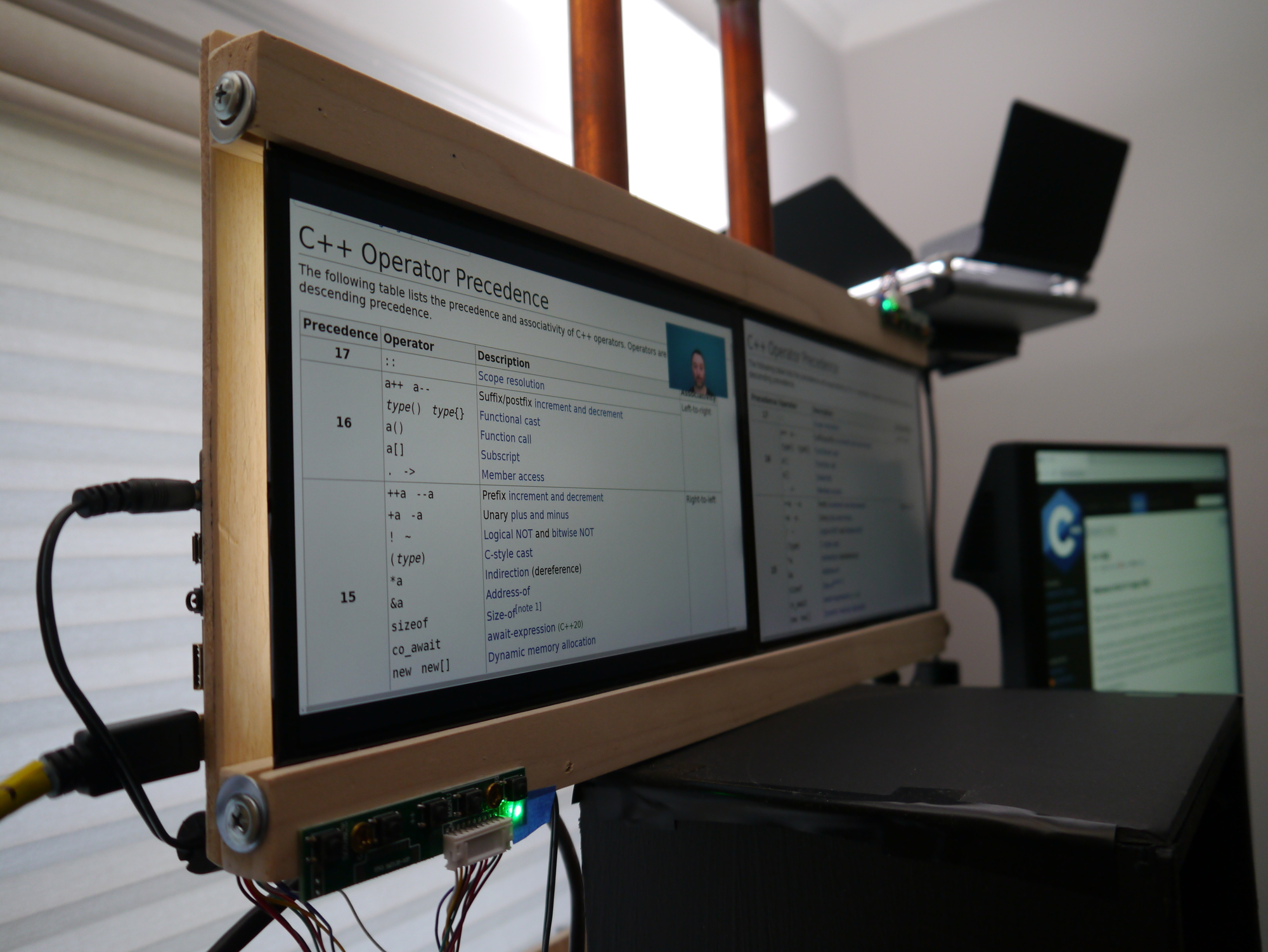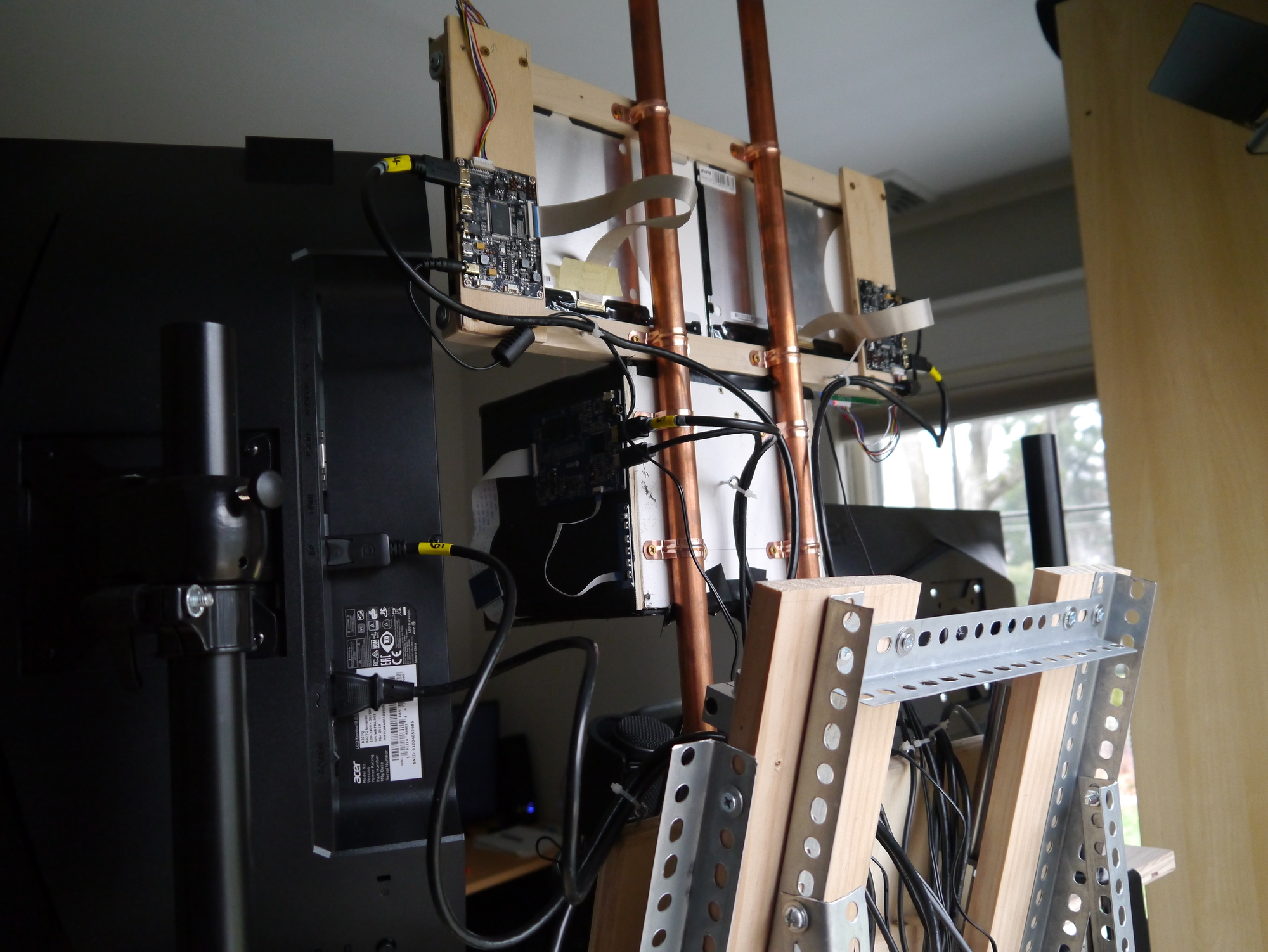Teaching Station: Displays
Remote teaching requires displays and display areas to be used for different purposes. But, how do you set up so many displays?
Well, we’re not talking about hundreds of displays, but more than would be common, and with different requirements to a developer. This post provides details about the display set up for my Mk III teaching station.
Displays
A developer will typically use different displays in the same way. They need to be able to read text on each screen and, assuming they’re not looking back and forth like they’re watching a tennis match, bigger is better.
An instructor needs to read text on some screens but not all of them; some will be used as capture targets for slides - a location from which we shouldn’t read! Also, smaller can be better here because it leads to greater density; the instructor can see more within their field of vision.
I personally, currently, have the following displays set up:
- Safe,
- RDP,
- Teleprompter,
- Output Monitoring,
- and Full-Screen Capture.
I would have liked more, but I am pushing the display limit with my graphics card, and I have to ask if I really need one, and practical experience has shown I don’t. What would go on another screen? The next one, for me, would be dedicated to the video-conferencing application.
Why not get one or two massive screens? That could work, but you’re are likely to run into problems when going full-screen. It’s easier to give the application its own screen to take over. In my original teaching station I used Virtual Display Manager to partition the screens into smaller regions. This worked pretty well but not always. I’d still recommend it if you don’t have the option of more displays. Even if you do not run into this problem, a strong point can be made that having dedicated screens with fixed purposes means less thinking and faffing as an instructor. You know the specific purpose of the display, and that’s its only purpose.
I took the monitors from my original teaching station and transferred them to the new station. One is the safe monitor that I can work on knowing that the monitor itself is never captured. The other I use to RDP to the client site, and I can capture part of it.
One of the other three is the screen used in the teleprompter. I discuss that in more detail in the teleprompter post.
The output monitor and full-screen capture, shown below, are not regular, full monitors.
Output Monitoring and Full-Screen Capture
Display Panels (rear)
The two panels I bought are 10.1" and capable of 2560x1600 (at least the driver is). I bought these from Amazon, but I later found laptopscreen.com. I haven’t ordered from them yet, but I certainly would in the future based on a question I raised with them.
Graphics Cards
I currently drive five screens. Originally I planned to drive six and needed a graphics card with enough chooch.
I initially tried a Sapphire Radeon 5870. It supports six displays. I had such high hopes until it was turned on. Maybe because it was second hand but, the fan noise was too much. The PC had been built as a quiet PC, but this card produced so much noise that the microphone would pick it up. It never claimed to be a quiet card so I can’t fault it.
I needed a quieter card, so I turned to quietpc.com. I don’t know how they do it, but they get things to me faster from the UK than local vendors do in the US. If you’re building a quiet PC, then please have a look (I am not affiliated). The ASUS GeForce GT710 Fanless looked perfect. It has four outputs and no fan. Sure, it doesn’t have the highest power for graphics, but we’re not doing any fancy 3D work for presenting.
If one was good, surely two would be better, supporting a maximum of eight displays! Now we’re talking. Alas no. The first issue was that OBS would only capture from the card it was running on. That was when I seriously swapped to XSplit. It will capture from a different graphics card to the one XSplit is running on. Something still wasn’t right, though. I just couldn’t get the frame rate to 30 fps, yet the GPU was never more than 50% in use for either card.
I never found the actual cause of the low frame rate, but I suspect that it wasn’t the GPU but the movement of data across the cards, possibly hitting a bottleneck copying the data. It was a moot point because XSplit was crashing on me, and after a few days of trying to diagnose that, I knew that I needed a quiet card that was more capable than the GT710 and could drive more than four displays.
I didn’t find anything with six outputs. However, DisplayPort outputs can be split. I currently have an ASRock Challenger ITX Radeon RX 5500 ($210). One of the outputs is split into two with a Rosewill RHUB-8K DisplayPort 1.4 3 Port Multi Monitor Splitter ($37). My five displays are being driven nicely, and I don’t think GPU or CPU ever go over 20%. Frame rate stays at 30fps.
HDMI Dummy Plugs - A Bonus Trick
Let’s say that you don’t have the space for another monitor, but you do have a spare output on the graphics card. It would be nice if there were a fake monitor attached. You could then use OBS, or some other screen capture application, to capture that fake monitor. This would allow PowerPoint, or some other tool, to go full screen. There is a way that you can do this - an HDMI dummy plug.
HDMI dummy plugs are dirt cheap and trick the graphics card into thinking that there is a physical monitor attached. They exist for DisplayPort as well. You might need to search using phrases like ‘headless’ or ‘ghost’.
Summary
Buying and arranging monitors for instructional use is different to development. At least some monitors will have a fixed purpose and should only display that one thing. Also, it can be more important to see more at once than greater detail.
You do not need to buy complete monitors. Panels and drivers can be bought individually, and this will lead to a more compact and light solution.
I’d recommend a single graphics card. 3D performance is not relevant, unlike the maximum number of displays that can be driven. Make sure that you buy one that will be quiet, even when working under load.
A dummy plug can be used to fake a physical display.

